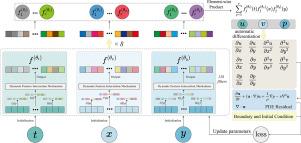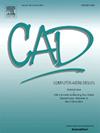DFS-PINN: A Dynamic Feature Separation Physics-Informed Neural Network
IF 3.1
3区 计算机科学
Q2 COMPUTER SCIENCE, SOFTWARE ENGINEERING
引用次数: 0
Abstract
Physics-Informed Neural Networks (PINNs) have shown great promise for solving partial differential equations (PDEs), but their application to multi-dimensional problems often suffers from the curse of dimensionality, leading to exponential growth in computational and memory requirements. Moreover, accurately capturing complex local features, such as those found in fluid flows, remains a significant challenge for existing approaches. To address these challenges, we propose the Dynamic Feature Separation Physics-Informed Neural Network (DFS-PINN), which introduces an innovative input-decoupling and dynamic interaction mechanism. This approach reduces computational complexity from to , enabling efficient training and improved accuracy for multi-dimensional problems, especially in real-time rendering and fluid simulations. When applied to the lid-driven cavity flow problem, DFS-PINN achieves a 6 reduction in runtime and a 62 reduction in memory usage with collocation points, compared to standard PINNs. For large-scale datasets with over points, DFS-PINN attains a mean squared error (MSE) of 0.000122, showcasing its superior computational efficiency and predictive accuracy. These results position DFS-PINN as a scalable and robust framework for solving multi-dimensional PDEs, demonstrating substantial improvements in both computational efficiency and modeling accuracy.

动态特征分离物理信息神经网络
物理信息神经网络(pinn)在解决偏微分方程(PDEs)方面显示出了巨大的希望,但它们在多维问题上的应用经常受到维度的诅咒,导致计算和内存需求呈指数级增长。此外,准确捕捉复杂的局部特征,例如在流体流动中发现的特征,仍然是现有方法面临的重大挑战。为了解决这些挑战,我们提出了动态特征分离物理信息神经网络(DFS-PINN),它引入了一种创新的输入解耦和动态交互机制。这种方法将计算复杂度从0 (Nd)降低到0 (N×d),实现了多维问题的高效训练并提高了精度,特别是在实时渲染和流体模拟中。当应用于盖子驱动的腔流问题时,与标准pinn相比,DFS-PINN在215个并置点上实现了6倍的运行时间减少和62倍的内存使用减少。对于超过220个点的大规模数据集,DFS-PINN的均方误差(MSE)为0.000122,显示出优越的计算效率和预测精度。这些结果将DFS-PINN定位为解决多维偏微分方程的可扩展和健壮的框架,在计算效率和建模精度方面都有实质性的改进。
本文章由计算机程序翻译,如有差异,请以英文原文为准。
求助全文
约1分钟内获得全文
求助全文
来源期刊

Computer-Aided Design
工程技术-计算机:软件工程
CiteScore
5.50
自引率
4.70%
发文量
117
审稿时长
4.2 months
期刊介绍:
Computer-Aided Design is a leading international journal that provides academia and industry with key papers on research and developments in the application of computers to design.
Computer-Aided Design invites papers reporting new research, as well as novel or particularly significant applications, within a wide range of topics, spanning all stages of design process from concept creation to manufacture and beyond.
 求助内容:
求助内容: 应助结果提醒方式:
应助结果提醒方式:


